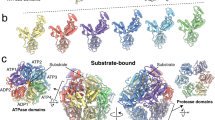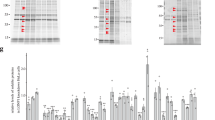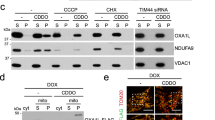Abstract
Mitochondrial aconitase is sensitive to oxidative inactivation and can aggregate and accumulate in many age-related disorders. Here we report that Lon protease, an ATP-stimulated mitochondrial matrix protein, selectively recognizes and degrades the oxidized, hydrophobic form of aconitase after mild oxidative modification, but that severe oxidation results in aconitase aggregation, which makes it a poor substrate for Lon. Similarly, a morpholino oligodeoxynucleotide directed against the lon gene markedly decreases the amount of Lon protein, Lon activity and aconitase degradation in WI-38 VA-13 human lung fibroblasts and causes accumulation of oxidatively modified aconitase. The ATP-stimulated Lon protease may be an essential defence against the stress of life in an oxygen environment. By recognizing minor oxidative changes to protein structure and rapidly degrading the mildly modified protein, Lon protease may prevent extensive oxidation, aggregation and accumulation of aconitase, which could otherwise compromise mitochondrial function and cellular viability. Aconitase is probably only one of many mitochondrial matrix proteins that are preferentially degraded by Lon protease after oxidative modification.
This is a preview of subscription content, access via your institution
Access options
Subscribe to this journal
Receive 12 print issues and online access
$209.00 per year
only $17.42 per issue
Buy this article
- Purchase on Springer Link
- Instant access to full article PDF
Prices may be subject to local taxes which are calculated during checkout







Similar content being viewed by others
References
Davies, K. J. Intracellular proteolytic systems may function as secondary antioxidant defenses: an hypothesis. Free Radic. Biol. Med. 2, 155–173 (1986).
Berlett, B. S. & Stadtman, E. R. Protein oxidation in aging, disease, and oxidative stress. J. Biol. Chem. 272, 20313–23136 (1997).
Grune, T., Reinheckel, T. & Davies, K. J. Degradation of oxidized proteins in mammalian cells. FASEB J. 11, 526–534 (1997).
Ullrich, O. et al. Poly ADP ribose polymerase activates nuclear proteasome to degrade oxidatively damaged histones. Proc. Natl Acad. Sci. USA 96, 6223–6228 (1999).
Sitte, N., Merker, K., Von Zglinicki, T., Davies, K. J. & Grune, T. Protein oxidation and degradation during cellular senescence of human BJ fibroblasts: part II—aging of nondividing cells. FASEB J. 14, 2503–2510 (2000).
Grune, T., Shringarpure, R., Sitte, N. & Davies, K. Age-related changes in protein oxidation and proteolysis in mammalian cells. J. Gerontol. Ser. A 56, B459–B467 (2001).
Rivett, A. J. Purification of a liver alkaline protease which degrades oxidatively modified glutamine synthetase. Characterization as a high molecular weight cysteine proteinase. J. Biol. Chem. 260, 12600–12606 (1985).
Levine, R. L., Oliver, C. N., Fulks, R. M. & Stadtman, E. R. Turnover of bacterial glutamine synthetase: oxidative inactivation precedes proteolysis. Proc. Natl Acad. Sci. USA 78, 2120–2124 (1981).
Davies, K. J. & Lin, S. W. Oxidatively denatured proteins are degraded by an ATP-independent proteolytic pathway in Escherichia coli. Free Radic. Biol. Med. 5, 225–236 (1988).
Marcillat, O., Zhang, Y., Lin, S. W. & Davies, K. J. Mitochondria contain a proteolytic system which can recognize and degrade oxidatively denatured proteins. Biochem. J. 254, 677–683 (1988).
Dean, R. T. & Pollak, J. K. Endogenous free radical generation may influence proteolysis in mitochondria. Biochem. Biophys. Res. Comm. 126, 1082–1089 (1985).
Chance, B., Sies, H. & Boveris, A. Hydroperoxide metabolism in mammalian organs. Physiol. Rev. 59, 527–605 (1979).
Davies, K. J. & Doroshow, J. H. Redox cycling of anthracyclines by cardiac mitochondria. I. Anthracycline radical formation by NADH dehydrogenase. J. Biol. Chem. 261, 3060–3067 (1986).
Zhang, Y., Marcillat, O., Giulivi, C., Ernster, L. & Davies, K. J. The oxidative inactivation of mitochondrial electron transport chain components and ATPase. J. Biol. Chem. 265, 16330–16336 (1990).
Doroshow, J. H. & Davies, K. J. Redox cycling of anthracyclines by cardiac mitochondria. II. Formation of superoxide anion, hydrogen peroxide, and hydroxyl radical. J. Biol. Chem. 261, 3068–3074 (1986).
Cadenas, E. & Davies, K. J. Mitochondrial free radical generation, oxidative stress, and aging. Free Radic. Biol. Med. 29, 222–230 (2000).
Marcillat, O., Zhang, Y. & Davies, K. J. Oxidative and non-oxidative mechanisms in the inactivation of cardiac mitochondrial electron transport chain components by doxorubicin. Biochem. J. 259, 181–189 (1989).
Sohal, R. S. & Dubey, A. Mitochondrial oxidative damage, hydrogen peroxide release, and aging. Free Radic. Biol. Med. 16, 621–626 (1994).
Yan, L. J. & Sohal, R. S. Mitochondrial adenine nucleotide translocase is modified oxidatively during aging. Proc. 95, 12896–12901 (1998).
Bota, D. A. & Davies, K. J. A. Protein degradation in mitochondria: implications for oxidative stress, aging and disease: a novel etiological classification of mitochondrial proteolytic disorders. Mitochondrion 1, 33–49 (2001).
Wang, N., Gottesman, S., Willingham, M. C., Gottesman, M. M. & Maurizi, M. R. A human mitochondrial ATP-dependent protease that is highly homologous to bacterial Lon protease. Proc. 90, 11247–11251 (1993).
Desautels, M. & Goldberg, A. L. Demonstration of an ATP-dependent, vanadate-sensitive endoprotease in the matrix of rat liver mitochondria. J. Biol. Chem. 257, 11673–11679 (1982).
Desautels, M. & Goldberg, A. L. Liver mitochondria contain an ATP-dependent, vanadate-sensitive pathway for the degradation of proteins. Proc. Natl Acad. Sci. USA 79, 1869–1873 (1982).
Rapoport, S., Dubiel, W. & Muller, M. Characteristics of an ATP-dependent proteolytic system of rat liver mitochondria. FEBS Lett. 147, 93–96 (1982).
Watabe, S. & Kimura, T. ATP-dependent protease in bovine adrenal cortex. Tissue specificity, subcellular localization, and partial characterization. J. Biol. Chem. 260, 5511–5517 (1985).
Watabe, S. & Kimura, T. Adrenal cortex mitochondrial enzyme with ATP-dependent protease and protein-dependent ATPase activities. Purification and properties. J. Biol. Chem. 260, 14498–14504 (1985).
Amerik, A. et al. Cloning and sequence analysis of cDNA for a human homolog of eubacterial ATP-dependent Lon proteases. FEBS Lett. 340, 25–28 (1994).
Suzuki, C. K., Suda, K., Wang, N. & Schatz, G. Requirement for the yeast gene LON in intramitochondrial proteolysis and maintenance of respiration. Science 264, 273–276 (1994); erratum ibid. 264, 891 (1994).
van Dyck, L., Neupert, W. & Langer, T. The ATP-dependent PIM1 protease is required for the expression of intron-containing genes in mitochondria. Genes Dev. 12, 1515–1524 (1998).
Van Dyck, L., Pearce, D. A. & Sherman, F. PIM1 encodes a mitochondrial ATP-dependent protease that is required for mitochondrial function in the yeast Saccharomyces cerevisiae. J. Biol. Chem. 269, 238–242 (1994).
Gardner, P. R., Nguyen, D. D. & White, C. W. Aconitase is a sensitive and critical target of oxygen poisoning in cultured mammalian cells and in rat lungs. Proc. Natl Acad. Sci. USA 91, 12248–12252 (1994).
Grune, T. et al. Peroxynitrite increases the degradation of aconitase and other cellular proteins by proteasome. J. Biol. Chem. 273, 10857–10862 (1998).
Giulivi, C., Pacifici, R. E. & Davies, K. J. Exposure of hydrophobic moieties promotes the selective degradation of hydrogen peroxide-modified hemoglobin by the multicatalytic proteinase complex, proteasome. Arch. Biochem. Biophys. 311, 329–341 (1994).
Davies, K. J., Lin, S. W. & Pacifici, R. E. Protein damage and degradation by oxygen radicals. IV. Degradation of denatured protein. J. Biol. Chem. 262, 9914–9920 (1987).
Ostrowska, H., Wojcik, C., Omura, S. & Worowski, K. Lactacystin, a specific inhibitor of the proteasome, inhibits human platelet lysosomal cathepsin A-like enzyme. Biochem. Biophys. Res. Comm. 234, 729–732 (1997).
Kuzela, S. & Goldberg, A. L. Mitochondrial ATP-dependent protease from rat liver and yeast. Methods Enzymol. 244, 376–383 (1994).
Gardner, P. R. Superoxide sensitivity of the Escherichia coli aconitase. J. Biol. Chem. 266, 19328–19333 (1991).
Gardner, P. R., Raineri, I., Epstein, L. B. & White, C. W. Superoxide radical and iron modulate aconitase activity in mammalian cells. J. Biol. Chem. 270, 13399–13405 (1995).
Kennedy, M. C. An EPR investigation of the products of the reaction of cytosolic and mitochondrial aconitases with nitric oxide. J. Biol. Chem. 272, 20340–20347 (1997).
Yan, L. J., Levine, R. L. & Sohal, R. S. Oxidative damage during aging targets mitochondrial aconitase. Proc. Natl Acad. Sci. USA 94, 11168–11172 (1997); erratum ibid. 95, 1968 (1998).
Williams, M. D. Increased oxidative damage is correlated to altered mitochondrial function in heterozygous manganese superoxide dismutase knockout mice. J. Biol. Chem. 273, 28510–28515 (1998).
Lass, A. Caloric restriction prevents age-associated accrual of oxidative damage to mouse skeletal muscle mitochondria. Free Radic. Biol. Med. 25, 1089–1097 (1998).
Das, N. Selectivity of protein oxidative damage during aging in Drosophila melanogaster. Biochem. J. 360, 209–216 (2001).
Park, L. C. Mitochondrial impairment in the cerebellum of the patients with progressive supranuclear palsy. J. Neurosci. Res. 66, 1028–1034 (2001).
Bradley, J. L. Clinical, biochemical and molecular genetic correlations in Friedreich's ataxia. Human Mol. Genet. 9, 275–282 (2000).
Tabrizi, S. J. Biochemical abnormalities and excitotoxicity in Huntington's disease brain. Ann. Neurol. 45, 25–32 (1999).
Lee, C. K., Klopp, R. G., Weindruch, R. & Prolla, T. A. Gene expression profile of aging and its retardation by caloric restriction. Science 285, 1390–1393 (1999).
Jentoft, N. & Dearborn, D. G. Labeling of proteins by reductive methylation using sodium cyanoborohydride. J. Biol. Chem. 254, 4359–4365 (1979).
Azzone, G. F., Colonna, R. & Ziche, B. Preparation of bovine heart mitochondria in high yield. Methods Enzymol. 55, 46–50 (1979).
Trounce, I. A., Kim, Y. L., Jun, A. S. & Wallace, D. C. Assessment of mitochondrial oxidative phosphorylation in patient muscle biopsies, lymphoblasts, and transmitochondrial cell lines. Methods Enzymol. 264, 484–509 (1996).
Hausladen, A. & Fridovich, I. Measuring nitric oxide and superoxide: rate constants for aconitase reactivity. Methods Enzymol. 269, 37–41 (1996).
Summerton, J. Morpholino antisense oligomers: design, preparation, and properties. Antisense Nucleic Acid Drug Dev. 7, 187–195 (1997).
Acknowledgements
This work was partially supported by NIH/NIEHS grant no. ES03598 and by NIH/NIA grant no. AG16256 to K.J.A.D.
Author information
Authors and Affiliations
Corresponding author
Ethics declarations
Competing interests
The authors declare no competing financial interests.
Rights and permissions
About this article
Cite this article
Bota, D., Davies, K. Lon protease preferentially degrades oxidized mitochondrial aconitase by an ATP-stimulated mechanism. Nat Cell Biol 4, 674–680 (2002). https://doi.org/10.1038/ncb836
Received:
Revised:
Accepted:
Published:
Issue Date:
DOI: https://doi.org/10.1038/ncb836
This article is cited by
-
Antagonistic effects of mitochondrial matrix and intermembrane space proteases on yeast aging
BMC Biology (2022)
-
LONP-1 and ATFS-1 sustain deleterious heteroplasmy by promoting mtDNA replication in dysfunctional mitochondria
Nature Cell Biology (2022)
-
Evidence for mitochondrial Lonp1 expression in the nucleus
Scientific Reports (2022)
-
Disuse-associated loss of the protease LONP1 in muscle impairs mitochondrial function and causes reduced skeletal muscle mass and strength
Nature Communications (2022)
-
Glyoxalase I activity affects Arabidopsis sensitivity to ammonium nutrition
Plant Cell Reports (2022)



